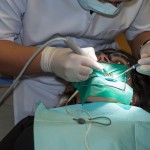
Internal bleaching, intracoronal or walking bleaching is a commonly used approach to manage discolouration of non-vital endodontically treated teeth. Compared with alternative treatments of veneers or crowns internal bleaching is a minimally invasive low-cost technique. Commonly used bleaching agents hydrogen peroxide, carbamide peroxide, and sodium perborate are placed in the pulp change of the affected tooth with a temporary restoration and replaced regularly until the desired colour is obtained.
The aim of this review was to compare the efficacy of different bleaching agents typically used for internal bleaching of endodontically treated discoloured teeth
Methods
Searches were conducted in the Medline, Cochrane CENTRAL and Web of Science databases for randomised (RCTs) and non-randomised controlled trials (nRCTs) of internal bleaching agents published in English or German. Two reviewers independently selected studies and extracted data with quality being assessed using the Cochrane risk of bias tool for RCTs and the Newcastle-Ottawa Scale for nRCTs. The main outcome was colour change measures as change in shade guide units (∆SGUs) and/or colour deviation using a spectrophotometer/colorimeter (∆E). Random effects meta-analyses and sub-group analyses were conducted.
Results
- 8 studies involving a total of 300 patients reported in 12 publications were included.
- 6 studies (3 RCTs, 2 nRCTs, 1 single-arm trial) were included in the meta-analyses.
- Overall internal bleaching led to significant changes in tooth shade
- ∆SGUs = 6.27 (95%CI: 5.36 to 7.17) [6 studies].
- ∆E = 12.83 (95%CI: 9.46 to 16.20) [3 studies].
- For ΔSGU, the use of carbamide peroxide (35% or 37%), hydrogen peroxide (35%), and the combination of sodium perborate and hydrogen peroxide (3% or 30%) led to a better bleaching effect than sodium perborate.
- For ΔE, there were no significant differences between the various bleaching agents.
Conclusions
The authors concluded: –
Carbamide peroxide, hydrogen peroxide, and sodium perborate have a significant bleaching effect on discoloured, root canal-treated teeth. For a valid assessment of shade stability and a comparison of bleaching agents and their concentrations, further studies with long-term recalls are necessary.
Comments
Several major databases were searched although restricting inclusion to publication in English and German may have excluded some relevant studies. Of the 8 included studies only 3 were randomised trials and none of them were at low risk of bias. The studies are small with only one involving more than 50 patients, bleaching protocols varied both in the number and frequency of bleaching session as well as the concentrations. Follow up periods varied with only 3 studies having follow up of 12 months or greater. Tooth colour was assessed using shade guides which is subjective and influenced by lighting conditions and other factors. Adverse effects were not reported. While the review found that bleaching agent resulted in changes in tooth shade the findings should be viewed cautiously as the available studies are of low quality. Future studies should be of appropriate size well-conducted and reported following the CONSORT statement and report on adverse events and patient relevant outcomes.
Links
Primary Paper
Frank AC, Kanzow P, Rödig T, Wiegand A. Comparison of the Bleaching Efficacy of Different Agents Used for Internal Bleaching: A Systematic Review and Meta-Analysis. J Endod. 2021 Nov 9:S0099-2399(21)00792-5. doi: 10.1016/j.joen.2021.10.011. Epub ahead of print. PMID: 34762968.
